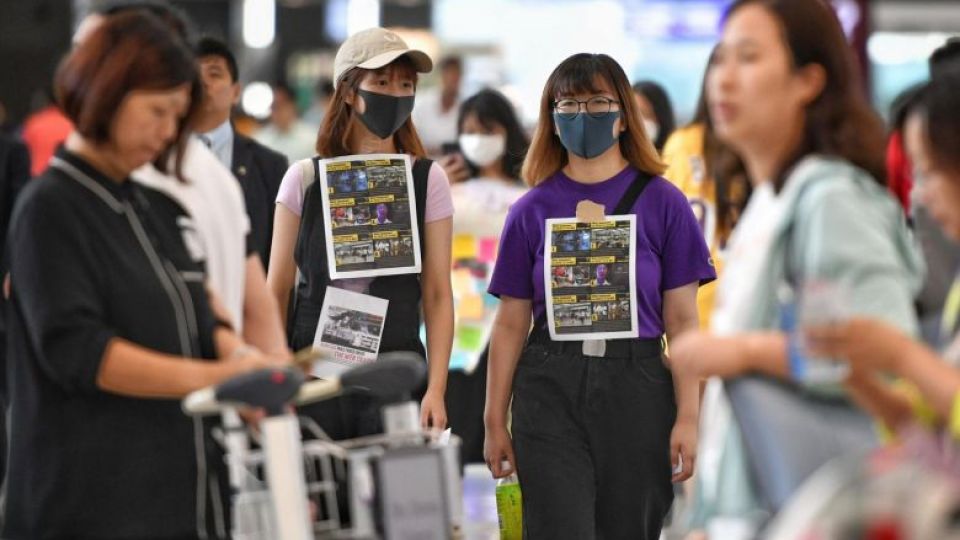August 2, 2019
Hong Kong’s ‘open source’ protests where everyone has a say in what to do is unprecedented.
On Tuesday afternoon (July 30), dozens of protesters showed up at the arrival hall of Hong Kong’s busy airport, holding up freshly-printed signs with information on recent protests that had escalated into clashes with the police.
In a sort of a silent flash mob, they walked around the airport with the signs, lingering for several hours before dispersing, as suddenly as they massed.
The gathering – a bid to spread the message of the anti-extradition Bill movement to foreigners visiting the city – had been planned mere hours earlier in a Telegram chat group.
It was just one of numerous instances of Hong Kong’s hive mind at work during the past eight weeks.
Since mass protests started in April against the extradition Bill that would allow for the handover of fugitives to several jurisdictions including mainland China, the movement has evolved: protesters have gone from calling for the complete scrapping of the Bill to protesting against police violence, government inaction and a call for social change.
But one thing remains clear: the movement is still largely leaderless.
Much of the action, including acts of civil disobedience like obstructing rush hour traffic on the trains, has been initiated by mostly young protesters who do most of their planning on the Reddit-like LIHKG forum, as well as in chat groups on secure messaging app Telegram.
Online, protesters exchange tips on what to do on the protest frontline, coordinate resources like helmets, masks and first aid supplies, and even plan when to leave following police clashes.
An online fundraising effort to take out anti-extradition advertisements in major international newspapers during the G20 meeting last month raised HK$5.4 million ($950,000) within days, enabling the protesters to place ads in at least eight publications including the Financial Times and the New York Times.
Even in a city where there is a long history of protests, the nature of this protest movement is unprecedented.
“This is like the Wikipedia of protests that individuals are free to contribute in whatever way they like, and where there’s no central organisation or group directing the efforts,” said lawyer Antony Daipiran, the author of “City of Protest: A History of Dissent in Hong Kong”.
The term “open-source protests” was first coined by Chinese University of Hong Kong journalism and communication professor Francis Lee, who likened the protesters’ organisation to app developers creating software using open source code.
“There is a constant evolution and refinement of techniques because everyone is allowed his own iteration of how to deal with the problem instead of having a main organiser deciding how things will go,” Professor Lee said at a talk in late June, adding that technology has allowed for creativity to flourish.
“The sense of participation is important because it allows for people to feel ownership over their actions,” he added.
Various segments of society have been coming together to help the mostly-young protesters in whatever way possible.
After police and protesters first faced off in violent clashes on June 12, several pro-democratic lawmakers and others set up the 612 Humanitarian Relief Fund.
It offers legal fees, medical fees and even living expenses for those who have been affected because of their involvement in the protests, said one of the fund’s trustees and popstar Denise Ho.
“The fund is for people who want to do something but who might not be able to attend every protest, or for whatever reason cannot be seen to be participating in protests,” she told The Straits Times.
Finance executive Simon, who declined to give his full name, set up an online store selling protective gear with four other friends.
While the mass rallies are largely peaceful, they have often resulted in clashes between police and a core group of protesters who stay behind. In recent days, the violence has been steadily escalating, with police firing increasing amounts of tear gas and rubber bullets to disperse protesters.
“We noticed in the early days that some were worried of buying gear from the shops in fear of getting recognised, so we set up HKProtect where people can be anonymous,” Simon said.
The equipment is sold at a small markup, he said, but the group also donates gear to protesters every week with plans to contribute their earnings to the 612 fund.
Others have been helping out in smaller ways like donating meal vouchers and single-trip metro tickets.
After local media reports said some young protesters, mostly students, were going hungry having spent most of their money buying protective gear, the internet kicked into gear, pooling together HK$200,000 in coupons which can be used in shops including fast food restaurants, bakeries, and supermarkets.
Yet this movement did not entirely start out leaderless.
In the beginning, pro-democracy group Civil Human Rights Front (CHRF) had organised most of the mass rallies, which drew millions. But its involvement has now changed to that of a supporting role.
“While we organised the initial protests, when others want to have their own take on it, including more extreme actions like storming the Legislative Council building, we don’t block them, we don’t tell them what to do but our group members simply are there to support in whatever way possible,” said CHRF vice-convenor Bonnie Leung.
She added that the group has also helped those who want to organise smaller protests by providing logistics support in crowd control, or even advice on how to apply for police permits.
“This new group of protesters, they don’t want to be told what to do,” Ms Leung said.


